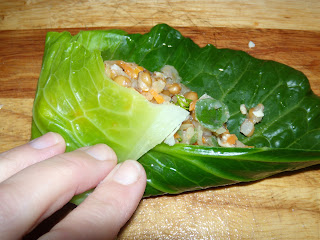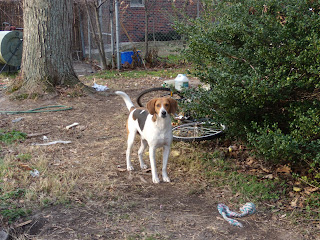I should preface my update on "The Little Tomato" with the fact that my fiance and I have three dogs and one cat, and all of them are rescues. This means that nobody else wanted them, and by taking them in, we probably saved their lives. The three dogs came from the SPCA of Northeastern North Carolina, and the cat from a total stranger on the Freecycle Network.
But my fiance has more sympathy for and patience with the underdog than even I do. This year I found a pathetic tomato plant that was sprouting in my fall garden. He wouldn't let me pull it up but has nurtured it. We've had unseasonably warm weather in Southeastern Virginia this year, and the plant was in a container along the North wall of the house, and we'd covered it with a cloche, but we finally had a cold snap about two weeks ago where he had to bring the tomato plant inside the house or lose it to a killing frost.
But I am a worrywart. And I knew that the tomato couldn't live in our dimly-lit living room. I watched the weather forecasts carefully, and when the days were supposed to be relatively warm and sunny, I'd been putting the tomato out on the front lawn to feed on the energy of the sun.
So, there we were, with me lugging the heavy planter onto the front lawn every day and my fiance lugging it back in each afternoon or evening as the temperatures started to drop. But the tomato was unhappy. It was exposed to winter winds, had insufficient light despite our efforts, and was looking increasingly poor.
So Don converted an old garbage can into a house for the tomato. He put a light in the lid and put the light on a timer. He put the tomato plant in its new home in a corner of our bedroom. Then he found a squash plant that had sprouted in the moist darkness of our worm composting-bin and decided to rescue THAT. So now we have a baby squash plant keeping the tomato company. And something else is coming up in the planter; Lord knows what! The plants get 14 hours of compact-fluorescent light a day. A regular plant light would be better, from what I've read, because it gives a broader spectrum of the lights plants need. The fluorescent tends to make plants grow leggy. But we'll have to risk it, because Don likes to conserve energy.
I'll post some pictures below of the tomato plant and its new companions. So far they are looking healthy, and the tomato has certainly turned quite green. The worrywart in me worries that the plants might need better air circulation. And if Don finds any more plants he wants to rescue, he's going to have to build us a greenhouse!
But my fiance has more sympathy for and patience with the underdog than even I do. This year I found a pathetic tomato plant that was sprouting in my fall garden. He wouldn't let me pull it up but has nurtured it. We've had unseasonably warm weather in Southeastern Virginia this year, and the plant was in a container along the North wall of the house, and we'd covered it with a cloche, but we finally had a cold snap about two weeks ago where he had to bring the tomato plant inside the house or lose it to a killing frost.
But I am a worrywart. And I knew that the tomato couldn't live in our dimly-lit living room. I watched the weather forecasts carefully, and when the days were supposed to be relatively warm and sunny, I'd been putting the tomato out on the front lawn to feed on the energy of the sun.
So, there we were, with me lugging the heavy planter onto the front lawn every day and my fiance lugging it back in each afternoon or evening as the temperatures started to drop. But the tomato was unhappy. It was exposed to winter winds, had insufficient light despite our efforts, and was looking increasingly poor.
So Don converted an old garbage can into a house for the tomato. He put a light in the lid and put the light on a timer. He put the tomato plant in its new home in a corner of our bedroom. Then he found a squash plant that had sprouted in the moist darkness of our worm composting-bin and decided to rescue THAT. So now we have a baby squash plant keeping the tomato company. And something else is coming up in the planter; Lord knows what! The plants get 14 hours of compact-fluorescent light a day. A regular plant light would be better, from what I've read, because it gives a broader spectrum of the lights plants need. The fluorescent tends to make plants grow leggy. But we'll have to risk it, because Don likes to conserve energy.
I'll post some pictures below of the tomato plant and its new companions. So far they are looking healthy, and the tomato has certainly turned quite green. The worrywart in me worries that the plants might need better air circulation. And if Don finds any more plants he wants to rescue, he's going to have to build us a greenhouse!























